Business Administration Report: Principles and Analysis (UK Grocery)
VerifiedAdded on 2020/11/23
|13
|3854
|386
Report
AI Summary
This report provides a comprehensive analysis of business administration principles, focusing on market characteristics, business innovation, and financial viability. It begins by examining different business markets, including B2B, B2C, industrial, and service markets, and explores the nature of interactions between businesses. The report then delves into organizational goals shaped by market dynamics and legal obligations. Key aspects of business innovation are discussed, including the use of innovation models, sources of support, and the product development process. The importance of financial viability, consequences of poor financial management, and financial terminology are also highlighted. Furthermore, the report covers budget management, marketing principles, the sales process, market research, brand value, and the relationship between sales and marketing. The report uses Unicorn Grocery as a case study to illustrate these concepts, offering insights into its operations and strategies. The report also explores the benefits, risks, and implications of innovation within a business context.
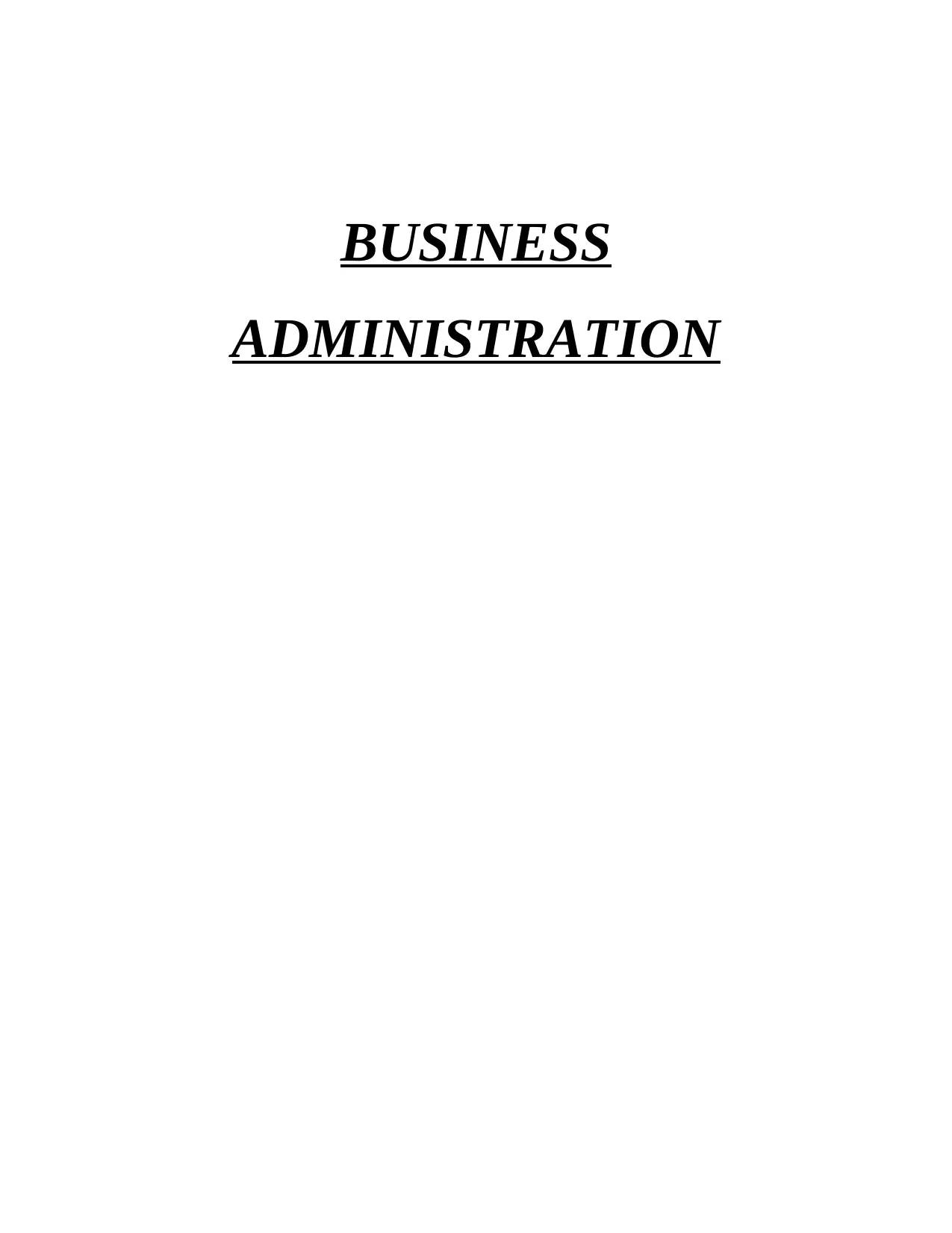
BUSINESS
ADMINISTRATION
ADMINISTRATION
Paraphrase This Document
Need a fresh take? Get an instant paraphrase of this document with our AI Paraphraser
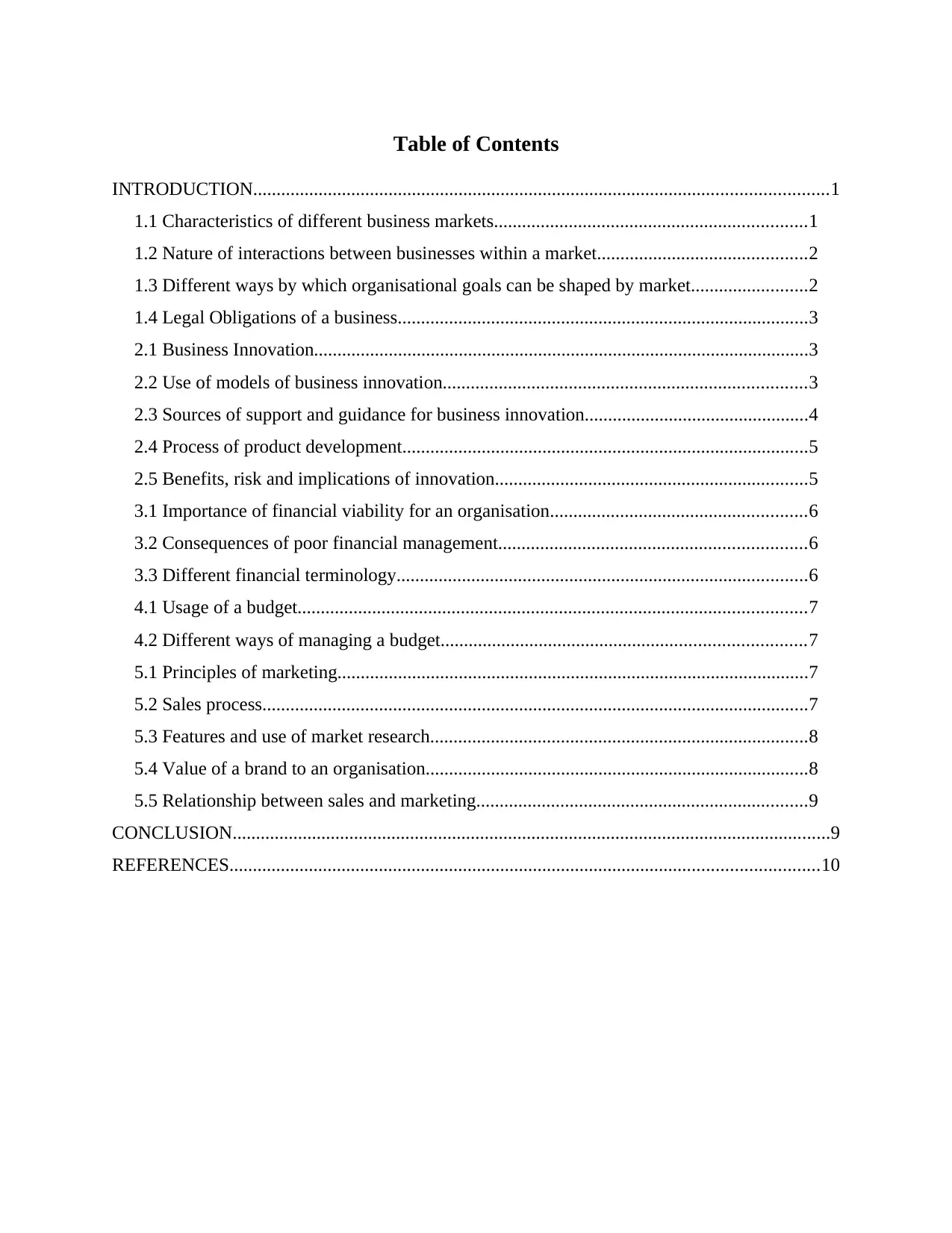
Table of Contents
INTRODUCTION...........................................................................................................................1
1.1 Characteristics of different business markets...................................................................1
1.2 Nature of interactions between businesses within a market.............................................2
1.3 Different ways by which organisational goals can be shaped by market.........................2
1.4 Legal Obligations of a business........................................................................................3
2.1 Business Innovation..........................................................................................................3
2.2 Use of models of business innovation..............................................................................3
2.3 Sources of support and guidance for business innovation................................................4
2.4 Process of product development.......................................................................................5
2.5 Benefits, risk and implications of innovation...................................................................5
3.1 Importance of financial viability for an organisation.......................................................6
3.2 Consequences of poor financial management..................................................................6
3.3 Different financial terminology........................................................................................6
4.1 Usage of a budget.............................................................................................................7
4.2 Different ways of managing a budget..............................................................................7
5.1 Principles of marketing.....................................................................................................7
5.2 Sales process.....................................................................................................................7
5.3 Features and use of market research.................................................................................8
5.4 Value of a brand to an organisation..................................................................................8
5.5 Relationship between sales and marketing.......................................................................9
CONCLUSION................................................................................................................................9
REFERENCES..............................................................................................................................10
INTRODUCTION...........................................................................................................................1
1.1 Characteristics of different business markets...................................................................1
1.2 Nature of interactions between businesses within a market.............................................2
1.3 Different ways by which organisational goals can be shaped by market.........................2
1.4 Legal Obligations of a business........................................................................................3
2.1 Business Innovation..........................................................................................................3
2.2 Use of models of business innovation..............................................................................3
2.3 Sources of support and guidance for business innovation................................................4
2.4 Process of product development.......................................................................................5
2.5 Benefits, risk and implications of innovation...................................................................5
3.1 Importance of financial viability for an organisation.......................................................6
3.2 Consequences of poor financial management..................................................................6
3.3 Different financial terminology........................................................................................6
4.1 Usage of a budget.............................................................................................................7
4.2 Different ways of managing a budget..............................................................................7
5.1 Principles of marketing.....................................................................................................7
5.2 Sales process.....................................................................................................................7
5.3 Features and use of market research.................................................................................8
5.4 Value of a brand to an organisation..................................................................................8
5.5 Relationship between sales and marketing.......................................................................9
CONCLUSION................................................................................................................................9
REFERENCES..............................................................................................................................10

⊘ This is a preview!⊘
Do you want full access?
Subscribe today to unlock all pages.

Trusted by 1+ million students worldwide
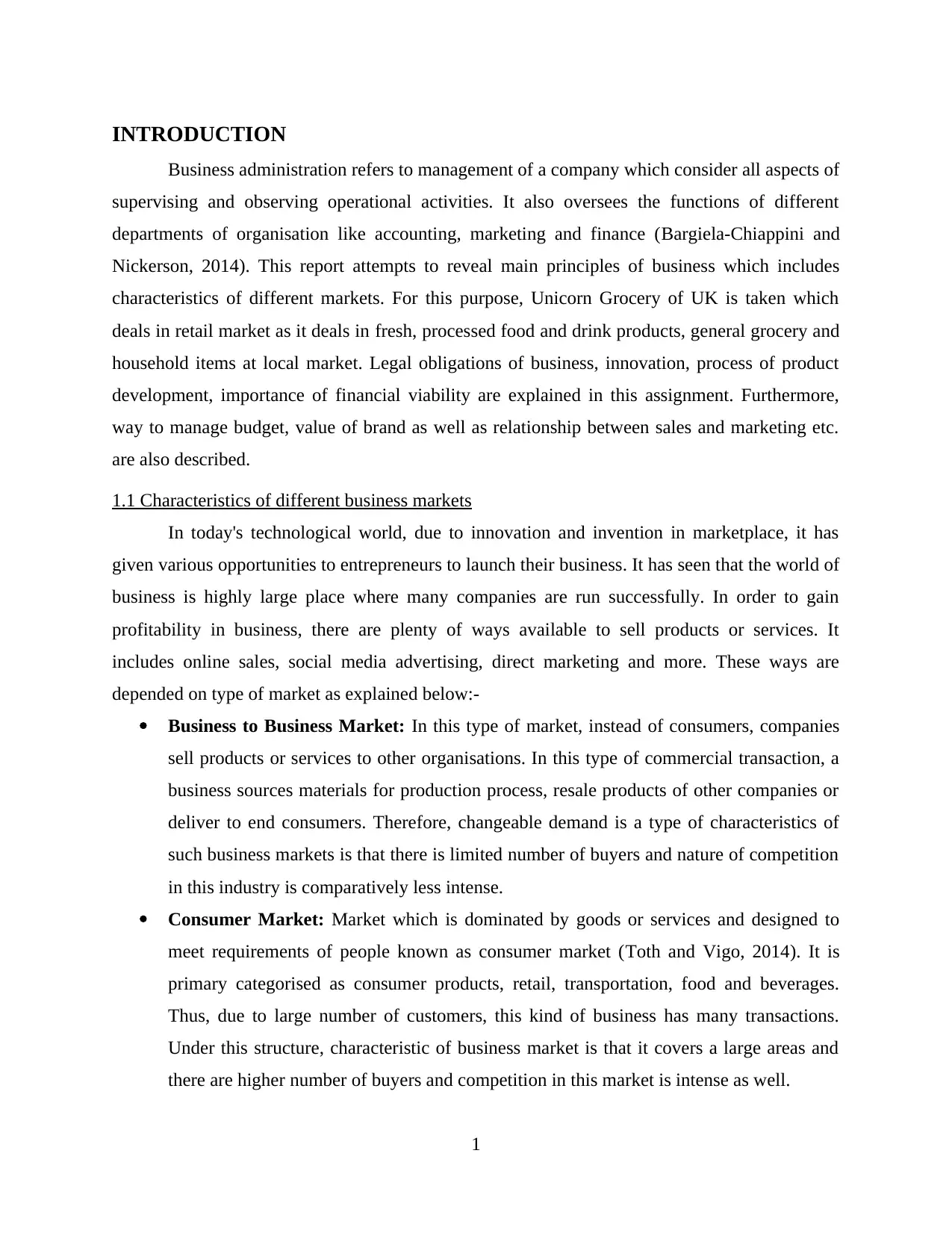
INTRODUCTION
Business administration refers to management of a company which consider all aspects of
supervising and observing operational activities. It also oversees the functions of different
departments of organisation like accounting, marketing and finance (Bargiela-Chiappini and
Nickerson, 2014). This report attempts to reveal main principles of business which includes
characteristics of different markets. For this purpose, Unicorn Grocery of UK is taken which
deals in retail market as it deals in fresh, processed food and drink products, general grocery and
household items at local market. Legal obligations of business, innovation, process of product
development, importance of financial viability are explained in this assignment. Furthermore,
way to manage budget, value of brand as well as relationship between sales and marketing etc.
are also described.
1.1 Characteristics of different business markets
In today's technological world, due to innovation and invention in marketplace, it has
given various opportunities to entrepreneurs to launch their business. It has seen that the world of
business is highly large place where many companies are run successfully. In order to gain
profitability in business, there are plenty of ways available to sell products or services. It
includes online sales, social media advertising, direct marketing and more. These ways are
depended on type of market as explained below:-
Business to Business Market: In this type of market, instead of consumers, companies
sell products or services to other organisations. In this type of commercial transaction, a
business sources materials for production process, resale products of other companies or
deliver to end consumers. Therefore, changeable demand is a type of characteristics of
such business markets is that there is limited number of buyers and nature of competition
in this industry is comparatively less intense.
Consumer Market: Market which is dominated by goods or services and designed to
meet requirements of people known as consumer market (Toth and Vigo, 2014). It is
primary categorised as consumer products, retail, transportation, food and beverages.
Thus, due to large number of customers, this kind of business has many transactions.
Under this structure, characteristic of business market is that it covers a large areas and
there are higher number of buyers and competition in this market is intense as well.
1
Business administration refers to management of a company which consider all aspects of
supervising and observing operational activities. It also oversees the functions of different
departments of organisation like accounting, marketing and finance (Bargiela-Chiappini and
Nickerson, 2014). This report attempts to reveal main principles of business which includes
characteristics of different markets. For this purpose, Unicorn Grocery of UK is taken which
deals in retail market as it deals in fresh, processed food and drink products, general grocery and
household items at local market. Legal obligations of business, innovation, process of product
development, importance of financial viability are explained in this assignment. Furthermore,
way to manage budget, value of brand as well as relationship between sales and marketing etc.
are also described.
1.1 Characteristics of different business markets
In today's technological world, due to innovation and invention in marketplace, it has
given various opportunities to entrepreneurs to launch their business. It has seen that the world of
business is highly large place where many companies are run successfully. In order to gain
profitability in business, there are plenty of ways available to sell products or services. It
includes online sales, social media advertising, direct marketing and more. These ways are
depended on type of market as explained below:-
Business to Business Market: In this type of market, instead of consumers, companies
sell products or services to other organisations. In this type of commercial transaction, a
business sources materials for production process, resale products of other companies or
deliver to end consumers. Therefore, changeable demand is a type of characteristics of
such business markets is that there is limited number of buyers and nature of competition
in this industry is comparatively less intense.
Consumer Market: Market which is dominated by goods or services and designed to
meet requirements of people known as consumer market (Toth and Vigo, 2014). It is
primary categorised as consumer products, retail, transportation, food and beverages.
Thus, due to large number of customers, this kind of business has many transactions.
Under this structure, characteristic of business market is that it covers a large areas and
there are higher number of buyers and competition in this market is intense as well.
1
Paraphrase This Document
Need a fresh take? Get an instant paraphrase of this document with our AI Paraphraser
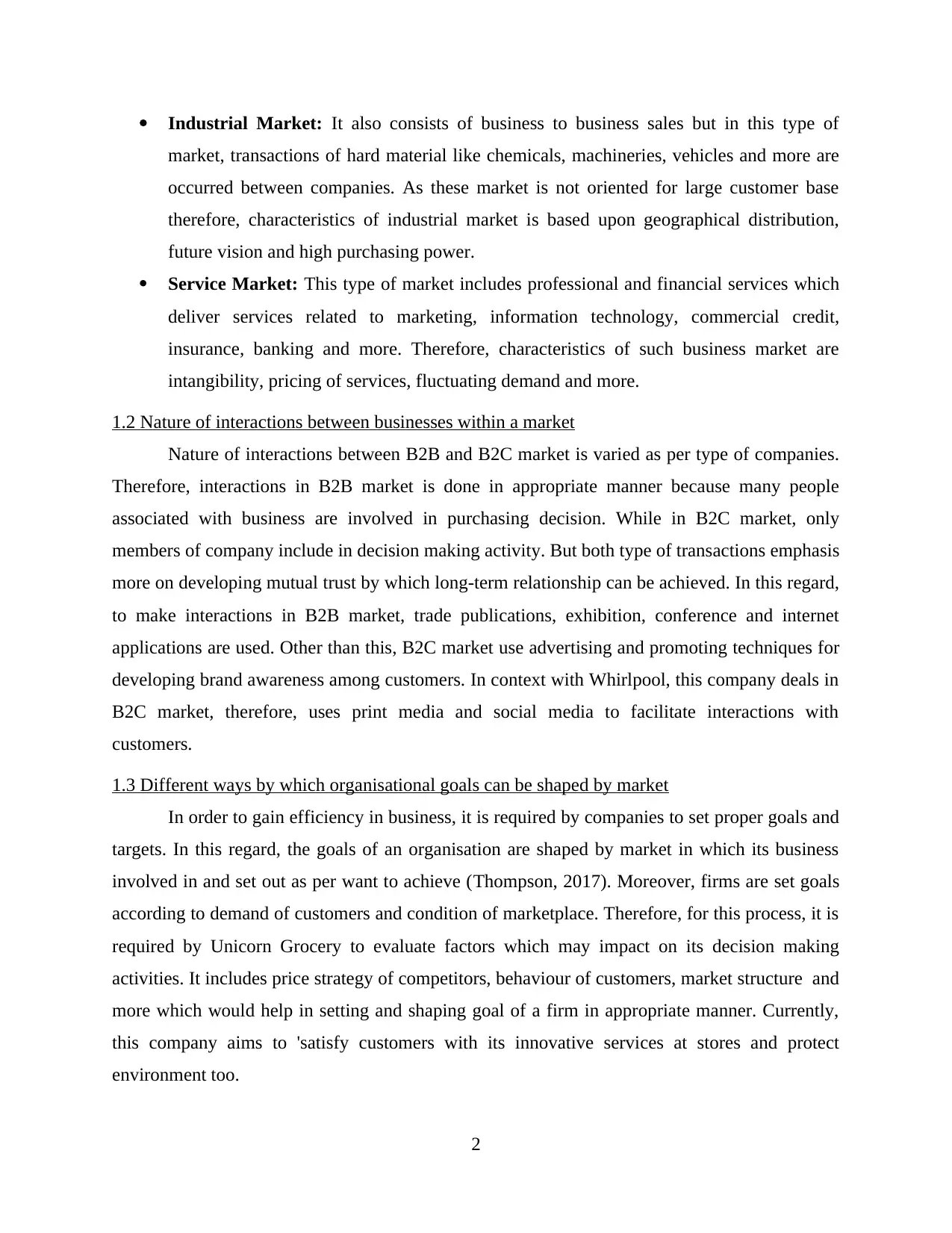
Industrial Market: It also consists of business to business sales but in this type of
market, transactions of hard material like chemicals, machineries, vehicles and more are
occurred between companies. As these market is not oriented for large customer base
therefore, characteristics of industrial market is based upon geographical distribution,
future vision and high purchasing power.
Service Market: This type of market includes professional and financial services which
deliver services related to marketing, information technology, commercial credit,
insurance, banking and more. Therefore, characteristics of such business market are
intangibility, pricing of services, fluctuating demand and more.
1.2 Nature of interactions between businesses within a market
Nature of interactions between B2B and B2C market is varied as per type of companies.
Therefore, interactions in B2B market is done in appropriate manner because many people
associated with business are involved in purchasing decision. While in B2C market, only
members of company include in decision making activity. But both type of transactions emphasis
more on developing mutual trust by which long-term relationship can be achieved. In this regard,
to make interactions in B2B market, trade publications, exhibition, conference and internet
applications are used. Other than this, B2C market use advertising and promoting techniques for
developing brand awareness among customers. In context with Whirlpool, this company deals in
B2C market, therefore, uses print media and social media to facilitate interactions with
customers.
1.3 Different ways by which organisational goals can be shaped by market
In order to gain efficiency in business, it is required by companies to set proper goals and
targets. In this regard, the goals of an organisation are shaped by market in which its business
involved in and set out as per want to achieve (Thompson, 2017). Moreover, firms are set goals
according to demand of customers and condition of marketplace. Therefore, for this process, it is
required by Unicorn Grocery to evaluate factors which may impact on its decision making
activities. It includes price strategy of competitors, behaviour of customers, market structure and
more which would help in setting and shaping goal of a firm in appropriate manner. Currently,
this company aims to 'satisfy customers with its innovative services at stores and protect
environment too.
2
market, transactions of hard material like chemicals, machineries, vehicles and more are
occurred between companies. As these market is not oriented for large customer base
therefore, characteristics of industrial market is based upon geographical distribution,
future vision and high purchasing power.
Service Market: This type of market includes professional and financial services which
deliver services related to marketing, information technology, commercial credit,
insurance, banking and more. Therefore, characteristics of such business market are
intangibility, pricing of services, fluctuating demand and more.
1.2 Nature of interactions between businesses within a market
Nature of interactions between B2B and B2C market is varied as per type of companies.
Therefore, interactions in B2B market is done in appropriate manner because many people
associated with business are involved in purchasing decision. While in B2C market, only
members of company include in decision making activity. But both type of transactions emphasis
more on developing mutual trust by which long-term relationship can be achieved. In this regard,
to make interactions in B2B market, trade publications, exhibition, conference and internet
applications are used. Other than this, B2C market use advertising and promoting techniques for
developing brand awareness among customers. In context with Whirlpool, this company deals in
B2C market, therefore, uses print media and social media to facilitate interactions with
customers.
1.3 Different ways by which organisational goals can be shaped by market
In order to gain efficiency in business, it is required by companies to set proper goals and
targets. In this regard, the goals of an organisation are shaped by market in which its business
involved in and set out as per want to achieve (Thompson, 2017). Moreover, firms are set goals
according to demand of customers and condition of marketplace. Therefore, for this process, it is
required by Unicorn Grocery to evaluate factors which may impact on its decision making
activities. It includes price strategy of competitors, behaviour of customers, market structure and
more which would help in setting and shaping goal of a firm in appropriate manner. Currently,
this company aims to 'satisfy customers with its innovative services at stores and protect
environment too.
2
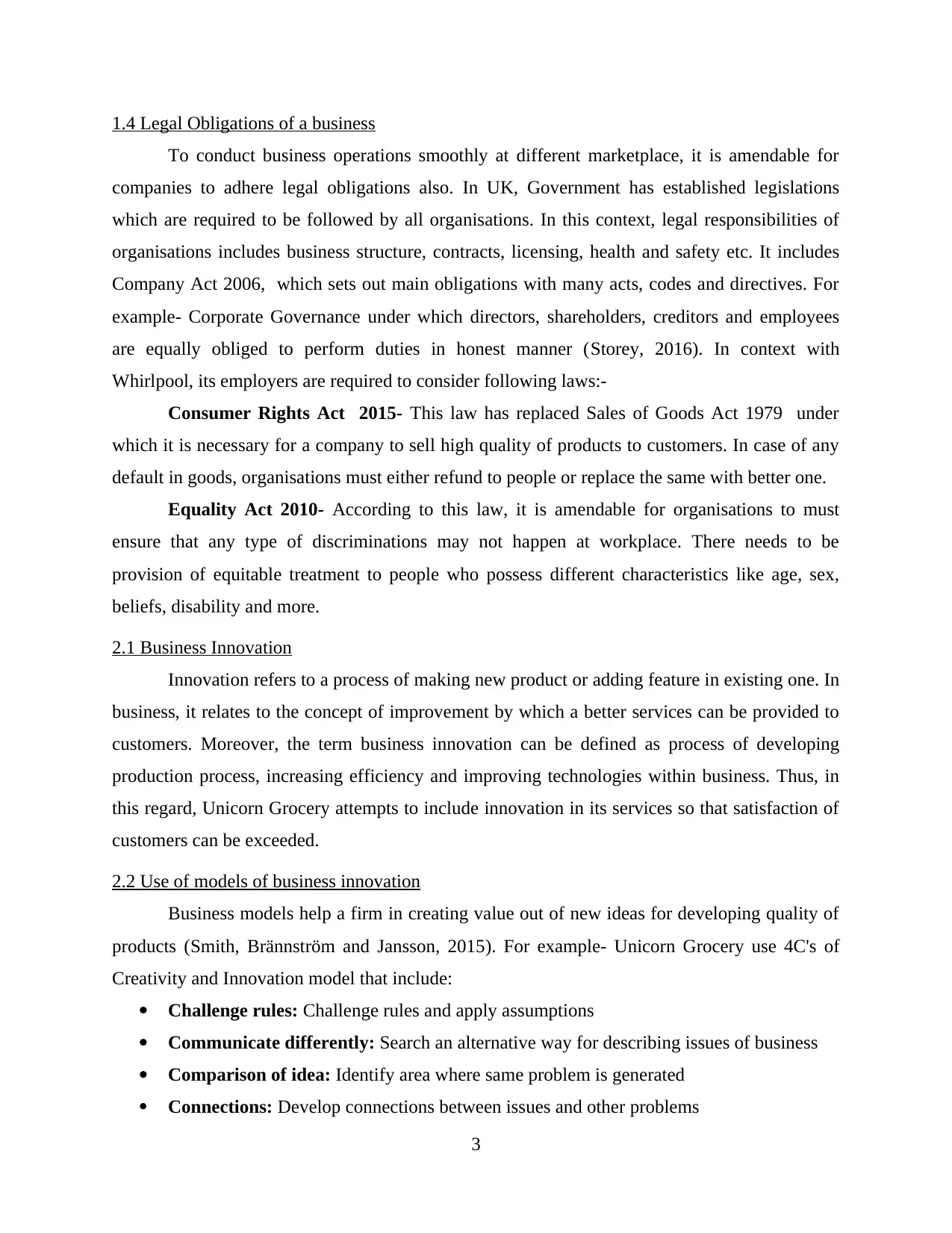
1.4 Legal Obligations of a business
To conduct business operations smoothly at different marketplace, it is amendable for
companies to adhere legal obligations also. In UK, Government has established legislations
which are required to be followed by all organisations. In this context, legal responsibilities of
organisations includes business structure, contracts, licensing, health and safety etc. It includes
Company Act 2006, which sets out main obligations with many acts, codes and directives. For
example- Corporate Governance under which directors, shareholders, creditors and employees
are equally obliged to perform duties in honest manner (Storey, 2016). In context with
Whirlpool, its employers are required to consider following laws:-
Consumer Rights Act 2015- This law has replaced Sales of Goods Act 1979 under
which it is necessary for a company to sell high quality of products to customers. In case of any
default in goods, organisations must either refund to people or replace the same with better one.
Equality Act 2010- According to this law, it is amendable for organisations to must
ensure that any type of discriminations may not happen at workplace. There needs to be
provision of equitable treatment to people who possess different characteristics like age, sex,
beliefs, disability and more.
2.1 Business Innovation
Innovation refers to a process of making new product or adding feature in existing one. In
business, it relates to the concept of improvement by which a better services can be provided to
customers. Moreover, the term business innovation can be defined as process of developing
production process, increasing efficiency and improving technologies within business. Thus, in
this regard, Unicorn Grocery attempts to include innovation in its services so that satisfaction of
customers can be exceeded.
2.2 Use of models of business innovation
Business models help a firm in creating value out of new ideas for developing quality of
products (Smith, Brännström and Jansson, 2015). For example- Unicorn Grocery use 4C's of
Creativity and Innovation model that include:
Challenge rules: Challenge rules and apply assumptions
Communicate differently: Search an alternative way for describing issues of business
Comparison of idea: Identify area where same problem is generated
Connections: Develop connections between issues and other problems
3
To conduct business operations smoothly at different marketplace, it is amendable for
companies to adhere legal obligations also. In UK, Government has established legislations
which are required to be followed by all organisations. In this context, legal responsibilities of
organisations includes business structure, contracts, licensing, health and safety etc. It includes
Company Act 2006, which sets out main obligations with many acts, codes and directives. For
example- Corporate Governance under which directors, shareholders, creditors and employees
are equally obliged to perform duties in honest manner (Storey, 2016). In context with
Whirlpool, its employers are required to consider following laws:-
Consumer Rights Act 2015- This law has replaced Sales of Goods Act 1979 under
which it is necessary for a company to sell high quality of products to customers. In case of any
default in goods, organisations must either refund to people or replace the same with better one.
Equality Act 2010- According to this law, it is amendable for organisations to must
ensure that any type of discriminations may not happen at workplace. There needs to be
provision of equitable treatment to people who possess different characteristics like age, sex,
beliefs, disability and more.
2.1 Business Innovation
Innovation refers to a process of making new product or adding feature in existing one. In
business, it relates to the concept of improvement by which a better services can be provided to
customers. Moreover, the term business innovation can be defined as process of developing
production process, increasing efficiency and improving technologies within business. Thus, in
this regard, Unicorn Grocery attempts to include innovation in its services so that satisfaction of
customers can be exceeded.
2.2 Use of models of business innovation
Business models help a firm in creating value out of new ideas for developing quality of
products (Smith, Brännström and Jansson, 2015). For example- Unicorn Grocery use 4C's of
Creativity and Innovation model that include:
Challenge rules: Challenge rules and apply assumptions
Communicate differently: Search an alternative way for describing issues of business
Comparison of idea: Identify area where same problem is generated
Connections: Develop connections between issues and other problems
3
⊘ This is a preview!⊘
Do you want full access?
Subscribe today to unlock all pages.

Trusted by 1+ million students worldwide
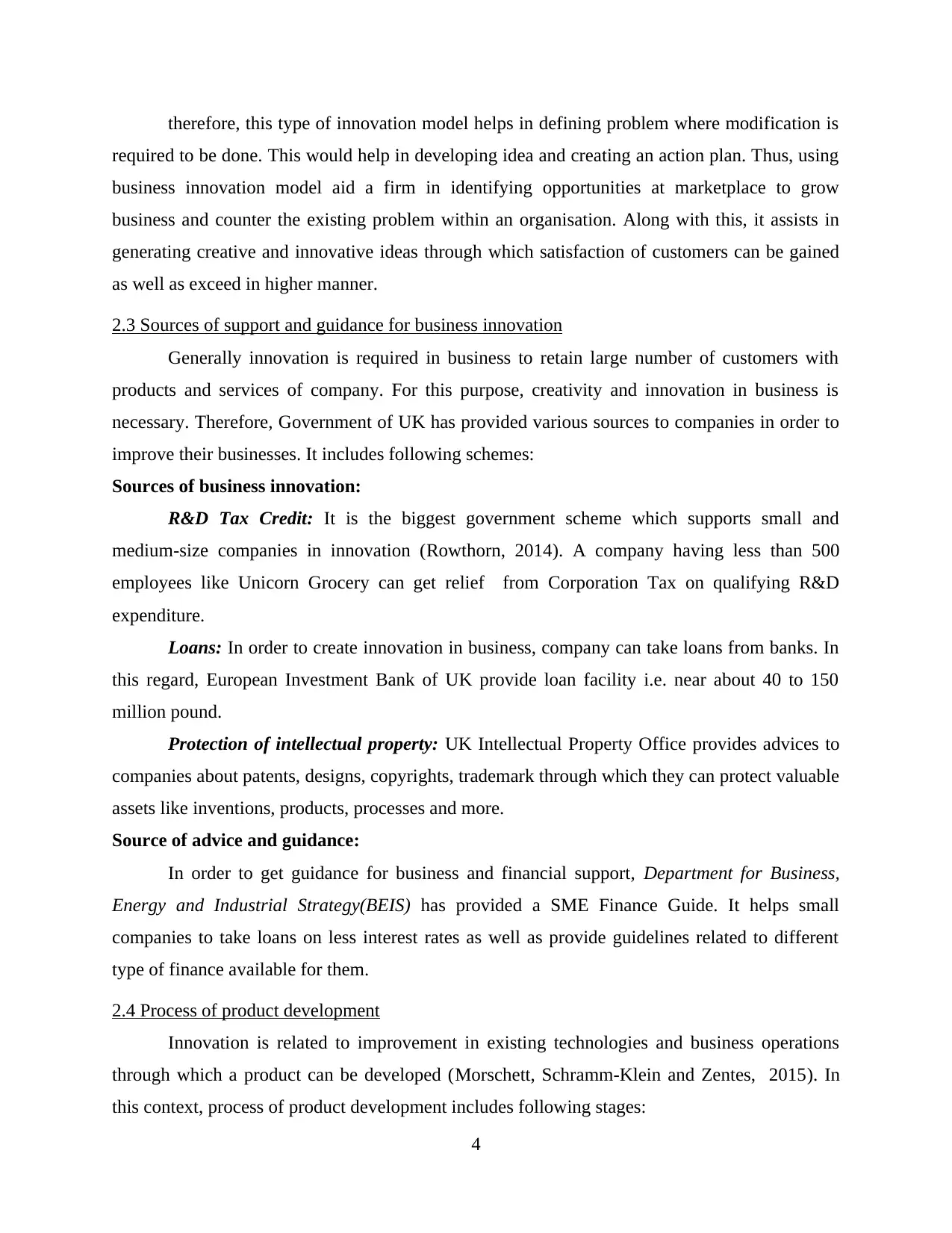
therefore, this type of innovation model helps in defining problem where modification is
required to be done. This would help in developing idea and creating an action plan. Thus, using
business innovation model aid a firm in identifying opportunities at marketplace to grow
business and counter the existing problem within an organisation. Along with this, it assists in
generating creative and innovative ideas through which satisfaction of customers can be gained
as well as exceed in higher manner.
2.3 Sources of support and guidance for business innovation
Generally innovation is required in business to retain large number of customers with
products and services of company. For this purpose, creativity and innovation in business is
necessary. Therefore, Government of UK has provided various sources to companies in order to
improve their businesses. It includes following schemes:
Sources of business innovation:
R&D Tax Credit: It is the biggest government scheme which supports small and
medium-size companies in innovation (Rowthorn, 2014). A company having less than 500
employees like Unicorn Grocery can get relief from Corporation Tax on qualifying R&D
expenditure.
Loans: In order to create innovation in business, company can take loans from banks. In
this regard, European Investment Bank of UK provide loan facility i.e. near about 40 to 150
million pound.
Protection of intellectual property: UK Intellectual Property Office provides advices to
companies about patents, designs, copyrights, trademark through which they can protect valuable
assets like inventions, products, processes and more.
Source of advice and guidance:
In order to get guidance for business and financial support, Department for Business,
Energy and Industrial Strategy(BEIS) has provided a SME Finance Guide. It helps small
companies to take loans on less interest rates as well as provide guidelines related to different
type of finance available for them.
2.4 Process of product development
Innovation is related to improvement in existing technologies and business operations
through which a product can be developed (Morschett, Schramm-Klein and Zentes, 2015). In
this context, process of product development includes following stages:
4
required to be done. This would help in developing idea and creating an action plan. Thus, using
business innovation model aid a firm in identifying opportunities at marketplace to grow
business and counter the existing problem within an organisation. Along with this, it assists in
generating creative and innovative ideas through which satisfaction of customers can be gained
as well as exceed in higher manner.
2.3 Sources of support and guidance for business innovation
Generally innovation is required in business to retain large number of customers with
products and services of company. For this purpose, creativity and innovation in business is
necessary. Therefore, Government of UK has provided various sources to companies in order to
improve their businesses. It includes following schemes:
Sources of business innovation:
R&D Tax Credit: It is the biggest government scheme which supports small and
medium-size companies in innovation (Rowthorn, 2014). A company having less than 500
employees like Unicorn Grocery can get relief from Corporation Tax on qualifying R&D
expenditure.
Loans: In order to create innovation in business, company can take loans from banks. In
this regard, European Investment Bank of UK provide loan facility i.e. near about 40 to 150
million pound.
Protection of intellectual property: UK Intellectual Property Office provides advices to
companies about patents, designs, copyrights, trademark through which they can protect valuable
assets like inventions, products, processes and more.
Source of advice and guidance:
In order to get guidance for business and financial support, Department for Business,
Energy and Industrial Strategy(BEIS) has provided a SME Finance Guide. It helps small
companies to take loans on less interest rates as well as provide guidelines related to different
type of finance available for them.
2.4 Process of product development
Innovation is related to improvement in existing technologies and business operations
through which a product can be developed (Morschett, Schramm-Klein and Zentes, 2015). In
this context, process of product development includes following stages:
4
Paraphrase This Document
Need a fresh take? Get an instant paraphrase of this document with our AI Paraphraser
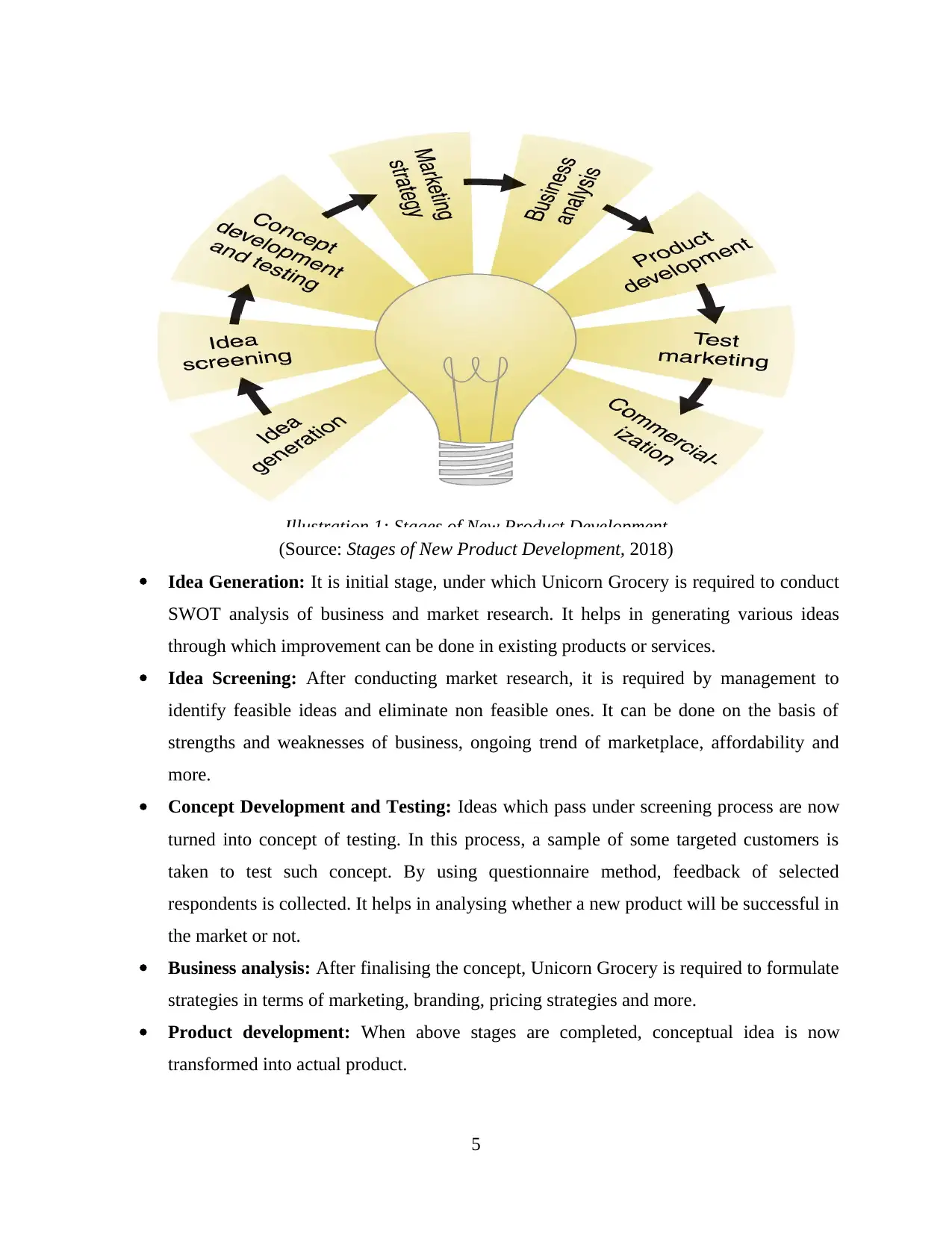
(Source: Stages of New Product Development, 2018)
Idea Generation: It is initial stage, under which Unicorn Grocery is required to conduct
SWOT analysis of business and market research. It helps in generating various ideas
through which improvement can be done in existing products or services.
Idea Screening: After conducting market research, it is required by management to
identify feasible ideas and eliminate non feasible ones. It can be done on the basis of
strengths and weaknesses of business, ongoing trend of marketplace, affordability and
more.
Concept Development and Testing: Ideas which pass under screening process are now
turned into concept of testing. In this process, a sample of some targeted customers is
taken to test such concept. By using questionnaire method, feedback of selected
respondents is collected. It helps in analysing whether a new product will be successful in
the market or not.
Business analysis: After finalising the concept, Unicorn Grocery is required to formulate
strategies in terms of marketing, branding, pricing strategies and more.
Product development: When above stages are completed, conceptual idea is now
transformed into actual product.
5
Illustration 1: Stages of New Product Development
Idea Generation: It is initial stage, under which Unicorn Grocery is required to conduct
SWOT analysis of business and market research. It helps in generating various ideas
through which improvement can be done in existing products or services.
Idea Screening: After conducting market research, it is required by management to
identify feasible ideas and eliminate non feasible ones. It can be done on the basis of
strengths and weaknesses of business, ongoing trend of marketplace, affordability and
more.
Concept Development and Testing: Ideas which pass under screening process are now
turned into concept of testing. In this process, a sample of some targeted customers is
taken to test such concept. By using questionnaire method, feedback of selected
respondents is collected. It helps in analysing whether a new product will be successful in
the market or not.
Business analysis: After finalising the concept, Unicorn Grocery is required to formulate
strategies in terms of marketing, branding, pricing strategies and more.
Product development: When above stages are completed, conceptual idea is now
transformed into actual product.
5
Illustration 1: Stages of New Product Development
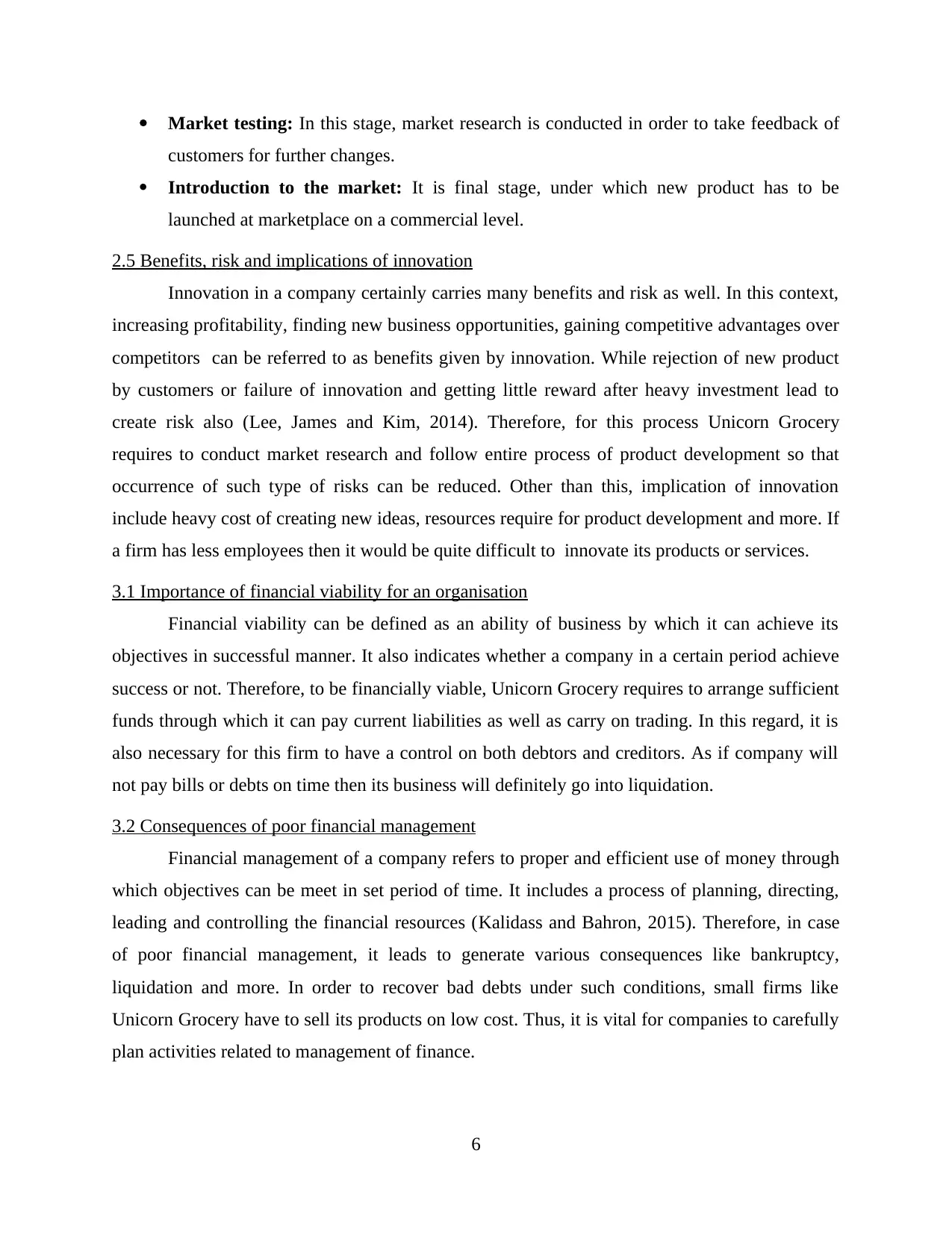
Market testing: In this stage, market research is conducted in order to take feedback of
customers for further changes.
Introduction to the market: It is final stage, under which new product has to be
launched at marketplace on a commercial level.
2.5 Benefits, risk and implications of innovation
Innovation in a company certainly carries many benefits and risk as well. In this context,
increasing profitability, finding new business opportunities, gaining competitive advantages over
competitors can be referred to as benefits given by innovation. While rejection of new product
by customers or failure of innovation and getting little reward after heavy investment lead to
create risk also (Lee, James and Kim, 2014). Therefore, for this process Unicorn Grocery
requires to conduct market research and follow entire process of product development so that
occurrence of such type of risks can be reduced. Other than this, implication of innovation
include heavy cost of creating new ideas, resources require for product development and more. If
a firm has less employees then it would be quite difficult to innovate its products or services.
3.1 Importance of financial viability for an organisation
Financial viability can be defined as an ability of business by which it can achieve its
objectives in successful manner. It also indicates whether a company in a certain period achieve
success or not. Therefore, to be financially viable, Unicorn Grocery requires to arrange sufficient
funds through which it can pay current liabilities as well as carry on trading. In this regard, it is
also necessary for this firm to have a control on both debtors and creditors. As if company will
not pay bills or debts on time then its business will definitely go into liquidation.
3.2 Consequences of poor financial management
Financial management of a company refers to proper and efficient use of money through
which objectives can be meet in set period of time. It includes a process of planning, directing,
leading and controlling the financial resources (Kalidass and Bahron, 2015). Therefore, in case
of poor financial management, it leads to generate various consequences like bankruptcy,
liquidation and more. In order to recover bad debts under such conditions, small firms like
Unicorn Grocery have to sell its products on low cost. Thus, it is vital for companies to carefully
plan activities related to management of finance.
6
customers for further changes.
Introduction to the market: It is final stage, under which new product has to be
launched at marketplace on a commercial level.
2.5 Benefits, risk and implications of innovation
Innovation in a company certainly carries many benefits and risk as well. In this context,
increasing profitability, finding new business opportunities, gaining competitive advantages over
competitors can be referred to as benefits given by innovation. While rejection of new product
by customers or failure of innovation and getting little reward after heavy investment lead to
create risk also (Lee, James and Kim, 2014). Therefore, for this process Unicorn Grocery
requires to conduct market research and follow entire process of product development so that
occurrence of such type of risks can be reduced. Other than this, implication of innovation
include heavy cost of creating new ideas, resources require for product development and more. If
a firm has less employees then it would be quite difficult to innovate its products or services.
3.1 Importance of financial viability for an organisation
Financial viability can be defined as an ability of business by which it can achieve its
objectives in successful manner. It also indicates whether a company in a certain period achieve
success or not. Therefore, to be financially viable, Unicorn Grocery requires to arrange sufficient
funds through which it can pay current liabilities as well as carry on trading. In this regard, it is
also necessary for this firm to have a control on both debtors and creditors. As if company will
not pay bills or debts on time then its business will definitely go into liquidation.
3.2 Consequences of poor financial management
Financial management of a company refers to proper and efficient use of money through
which objectives can be meet in set period of time. It includes a process of planning, directing,
leading and controlling the financial resources (Kalidass and Bahron, 2015). Therefore, in case
of poor financial management, it leads to generate various consequences like bankruptcy,
liquidation and more. In order to recover bad debts under such conditions, small firms like
Unicorn Grocery have to sell its products on low cost. Thus, it is vital for companies to carefully
plan activities related to management of finance.
6
⊘ This is a preview!⊘
Do you want full access?
Subscribe today to unlock all pages.

Trusted by 1+ million students worldwide
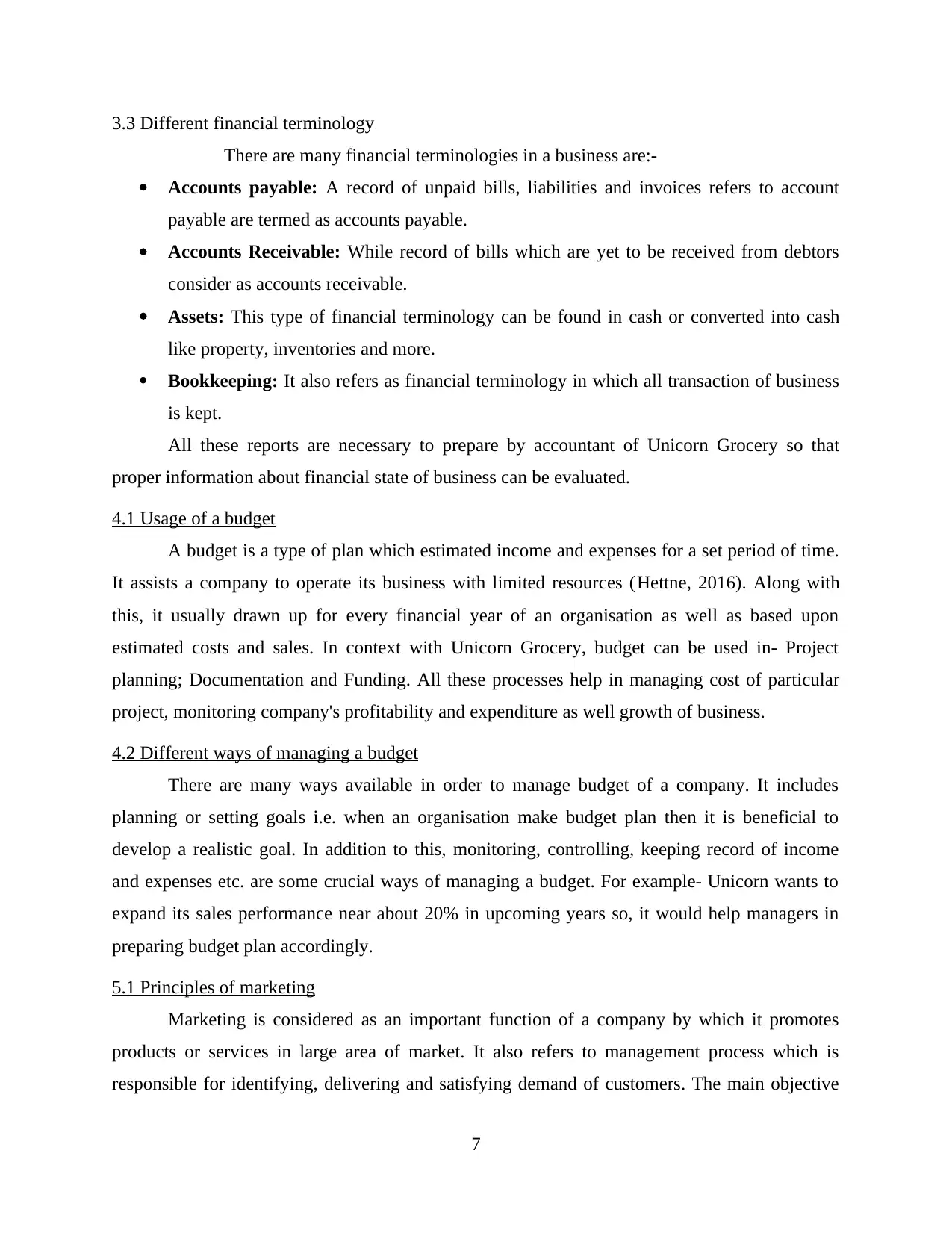
3.3 Different financial terminology
There are many financial terminologies in a business are:-
Accounts payable: A record of unpaid bills, liabilities and invoices refers to account
payable are termed as accounts payable.
Accounts Receivable: While record of bills which are yet to be received from debtors
consider as accounts receivable.
Assets: This type of financial terminology can be found in cash or converted into cash
like property, inventories and more.
Bookkeeping: It also refers as financial terminology in which all transaction of business
is kept.
All these reports are necessary to prepare by accountant of Unicorn Grocery so that
proper information about financial state of business can be evaluated.
4.1 Usage of a budget
A budget is a type of plan which estimated income and expenses for a set period of time.
It assists a company to operate its business with limited resources (Hettne, 2016). Along with
this, it usually drawn up for every financial year of an organisation as well as based upon
estimated costs and sales. In context with Unicorn Grocery, budget can be used in- Project
planning; Documentation and Funding. All these processes help in managing cost of particular
project, monitoring company's profitability and expenditure as well growth of business.
4.2 Different ways of managing a budget
There are many ways available in order to manage budget of a company. It includes
planning or setting goals i.e. when an organisation make budget plan then it is beneficial to
develop a realistic goal. In addition to this, monitoring, controlling, keeping record of income
and expenses etc. are some crucial ways of managing a budget. For example- Unicorn wants to
expand its sales performance near about 20% in upcoming years so, it would help managers in
preparing budget plan accordingly.
5.1 Principles of marketing
Marketing is considered as an important function of a company by which it promotes
products or services in large area of market. It also refers to management process which is
responsible for identifying, delivering and satisfying demand of customers. The main objective
7
There are many financial terminologies in a business are:-
Accounts payable: A record of unpaid bills, liabilities and invoices refers to account
payable are termed as accounts payable.
Accounts Receivable: While record of bills which are yet to be received from debtors
consider as accounts receivable.
Assets: This type of financial terminology can be found in cash or converted into cash
like property, inventories and more.
Bookkeeping: It also refers as financial terminology in which all transaction of business
is kept.
All these reports are necessary to prepare by accountant of Unicorn Grocery so that
proper information about financial state of business can be evaluated.
4.1 Usage of a budget
A budget is a type of plan which estimated income and expenses for a set period of time.
It assists a company to operate its business with limited resources (Hettne, 2016). Along with
this, it usually drawn up for every financial year of an organisation as well as based upon
estimated costs and sales. In context with Unicorn Grocery, budget can be used in- Project
planning; Documentation and Funding. All these processes help in managing cost of particular
project, monitoring company's profitability and expenditure as well growth of business.
4.2 Different ways of managing a budget
There are many ways available in order to manage budget of a company. It includes
planning or setting goals i.e. when an organisation make budget plan then it is beneficial to
develop a realistic goal. In addition to this, monitoring, controlling, keeping record of income
and expenses etc. are some crucial ways of managing a budget. For example- Unicorn wants to
expand its sales performance near about 20% in upcoming years so, it would help managers in
preparing budget plan accordingly.
5.1 Principles of marketing
Marketing is considered as an important function of a company by which it promotes
products or services in large area of market. It also refers to management process which is
responsible for identifying, delivering and satisfying demand of customers. The main objective
7
Paraphrase This Document
Need a fresh take? Get an instant paraphrase of this document with our AI Paraphraser
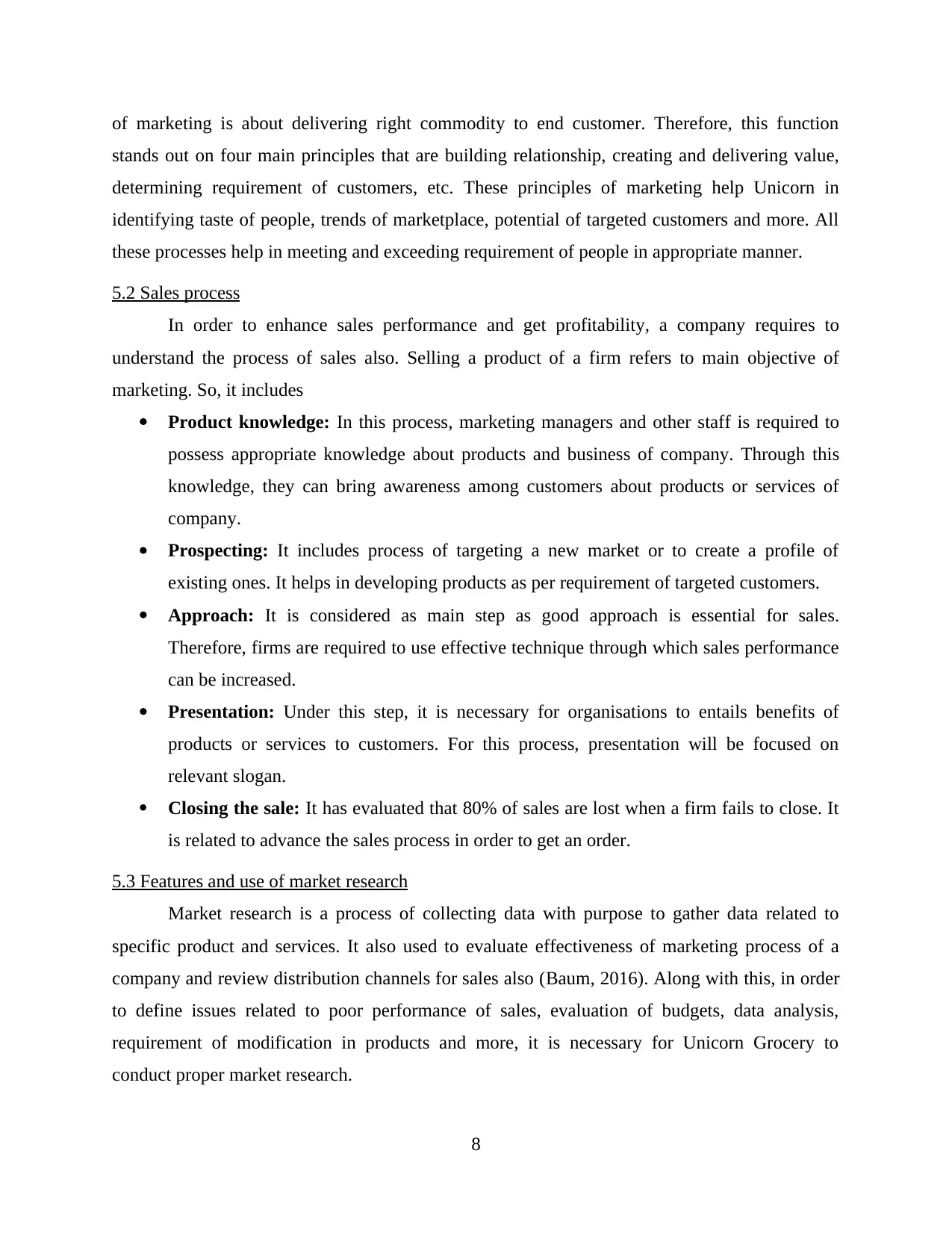
of marketing is about delivering right commodity to end customer. Therefore, this function
stands out on four main principles that are building relationship, creating and delivering value,
determining requirement of customers, etc. These principles of marketing help Unicorn in
identifying taste of people, trends of marketplace, potential of targeted customers and more. All
these processes help in meeting and exceeding requirement of people in appropriate manner.
5.2 Sales process
In order to enhance sales performance and get profitability, a company requires to
understand the process of sales also. Selling a product of a firm refers to main objective of
marketing. So, it includes
Product knowledge: In this process, marketing managers and other staff is required to
possess appropriate knowledge about products and business of company. Through this
knowledge, they can bring awareness among customers about products or services of
company.
Prospecting: It includes process of targeting a new market or to create a profile of
existing ones. It helps in developing products as per requirement of targeted customers.
Approach: It is considered as main step as good approach is essential for sales.
Therefore, firms are required to use effective technique through which sales performance
can be increased.
Presentation: Under this step, it is necessary for organisations to entails benefits of
products or services to customers. For this process, presentation will be focused on
relevant slogan.
Closing the sale: It has evaluated that 80% of sales are lost when a firm fails to close. It
is related to advance the sales process in order to get an order.
5.3 Features and use of market research
Market research is a process of collecting data with purpose to gather data related to
specific product and services. It also used to evaluate effectiveness of marketing process of a
company and review distribution channels for sales also (Baum, 2016). Along with this, in order
to define issues related to poor performance of sales, evaluation of budgets, data analysis,
requirement of modification in products and more, it is necessary for Unicorn Grocery to
conduct proper market research.
8
stands out on four main principles that are building relationship, creating and delivering value,
determining requirement of customers, etc. These principles of marketing help Unicorn in
identifying taste of people, trends of marketplace, potential of targeted customers and more. All
these processes help in meeting and exceeding requirement of people in appropriate manner.
5.2 Sales process
In order to enhance sales performance and get profitability, a company requires to
understand the process of sales also. Selling a product of a firm refers to main objective of
marketing. So, it includes
Product knowledge: In this process, marketing managers and other staff is required to
possess appropriate knowledge about products and business of company. Through this
knowledge, they can bring awareness among customers about products or services of
company.
Prospecting: It includes process of targeting a new market or to create a profile of
existing ones. It helps in developing products as per requirement of targeted customers.
Approach: It is considered as main step as good approach is essential for sales.
Therefore, firms are required to use effective technique through which sales performance
can be increased.
Presentation: Under this step, it is necessary for organisations to entails benefits of
products or services to customers. For this process, presentation will be focused on
relevant slogan.
Closing the sale: It has evaluated that 80% of sales are lost when a firm fails to close. It
is related to advance the sales process in order to get an order.
5.3 Features and use of market research
Market research is a process of collecting data with purpose to gather data related to
specific product and services. It also used to evaluate effectiveness of marketing process of a
company and review distribution channels for sales also (Baum, 2016). Along with this, in order
to define issues related to poor performance of sales, evaluation of budgets, data analysis,
requirement of modification in products and more, it is necessary for Unicorn Grocery to
conduct proper market research.
8
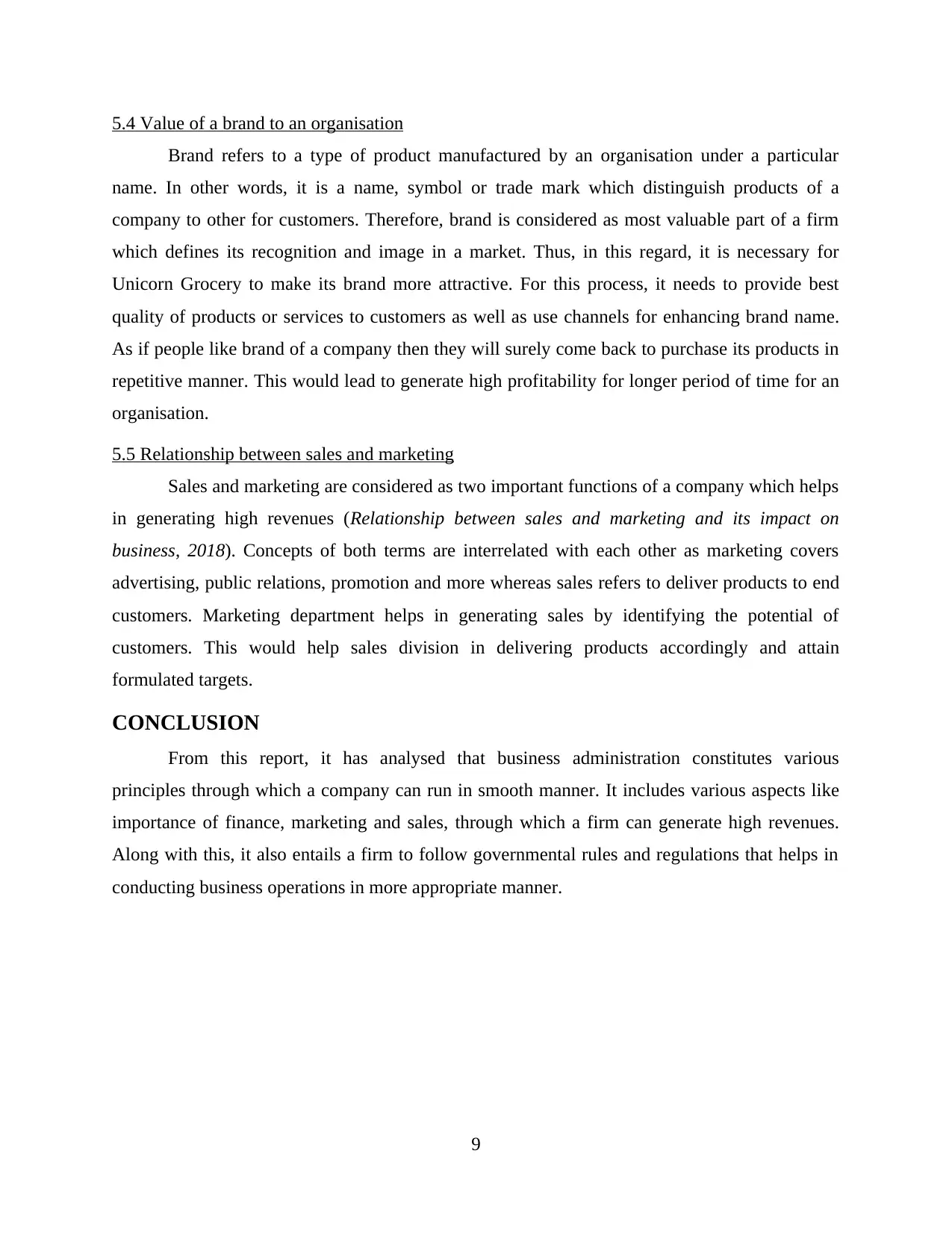
5.4 Value of a brand to an organisation
Brand refers to a type of product manufactured by an organisation under a particular
name. In other words, it is a name, symbol or trade mark which distinguish products of a
company to other for customers. Therefore, brand is considered as most valuable part of a firm
which defines its recognition and image in a market. Thus, in this regard, it is necessary for
Unicorn Grocery to make its brand more attractive. For this process, it needs to provide best
quality of products or services to customers as well as use channels for enhancing brand name.
As if people like brand of a company then they will surely come back to purchase its products in
repetitive manner. This would lead to generate high profitability for longer period of time for an
organisation.
5.5 Relationship between sales and marketing
Sales and marketing are considered as two important functions of a company which helps
in generating high revenues (Relationship between sales and marketing and its impact on
business, 2018). Concepts of both terms are interrelated with each other as marketing covers
advertising, public relations, promotion and more whereas sales refers to deliver products to end
customers. Marketing department helps in generating sales by identifying the potential of
customers. This would help sales division in delivering products accordingly and attain
formulated targets.
CONCLUSION
From this report, it has analysed that business administration constitutes various
principles through which a company can run in smooth manner. It includes various aspects like
importance of finance, marketing and sales, through which a firm can generate high revenues.
Along with this, it also entails a firm to follow governmental rules and regulations that helps in
conducting business operations in more appropriate manner.
9
Brand refers to a type of product manufactured by an organisation under a particular
name. In other words, it is a name, symbol or trade mark which distinguish products of a
company to other for customers. Therefore, brand is considered as most valuable part of a firm
which defines its recognition and image in a market. Thus, in this regard, it is necessary for
Unicorn Grocery to make its brand more attractive. For this process, it needs to provide best
quality of products or services to customers as well as use channels for enhancing brand name.
As if people like brand of a company then they will surely come back to purchase its products in
repetitive manner. This would lead to generate high profitability for longer period of time for an
organisation.
5.5 Relationship between sales and marketing
Sales and marketing are considered as two important functions of a company which helps
in generating high revenues (Relationship between sales and marketing and its impact on
business, 2018). Concepts of both terms are interrelated with each other as marketing covers
advertising, public relations, promotion and more whereas sales refers to deliver products to end
customers. Marketing department helps in generating sales by identifying the potential of
customers. This would help sales division in delivering products accordingly and attain
formulated targets.
CONCLUSION
From this report, it has analysed that business administration constitutes various
principles through which a company can run in smooth manner. It includes various aspects like
importance of finance, marketing and sales, through which a firm can generate high revenues.
Along with this, it also entails a firm to follow governmental rules and regulations that helps in
conducting business operations in more appropriate manner.
9
⊘ This is a preview!⊘
Do you want full access?
Subscribe today to unlock all pages.

Trusted by 1+ million students worldwide
1 out of 13
Related Documents
Your All-in-One AI-Powered Toolkit for Academic Success.
+13062052269
info@desklib.com
Available 24*7 on WhatsApp / Email
![[object Object]](/_next/static/media/star-bottom.7253800d.svg)
Unlock your academic potential
Copyright © 2020–2025 A2Z Services. All Rights Reserved. Developed and managed by ZUCOL.





